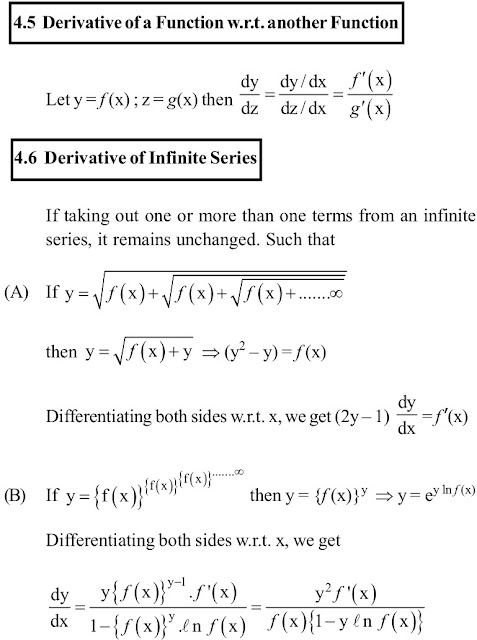APPLICATIONS OF DERIVATIVE
SOME IMPORTANT FORMULAE/KEYCONCEPTS
-
RATE OF CHANGE OF QUANTITIES
Whenever one quantity y varies with another quantity x, satisfying some rule y = f(x), then \(\dfrac{{dy}}{{dx}}\) or f'(x) represents the rate of change of y with resprect to x and \({\left[ {\dfrac{{dy}}{{dx}}} \right]_{x = {x_0}}}\) or f'(x0) represents rate of change of y with resprect to x at x = x0
EXAMPLE :
QUESTION :The radius of a circle is increasing at the rate of 0.7 cm/s. What is the rate of increase of its circumference?
SOLUTION :Let any instant of time t, the radius of circle = r
Then, circumference C = \(2\pi r\)
Diff. Both sides w.r.t t, we get\(\dfrac{{dC}}{{dt}} = \dfrac{{d(2\pi r)}}{{dt}} = 2\pi \dfrac{{dr}}{{dt}}\)
\(\dfrac{{dr}}{{dt}} = 0.7\,\,cm/s\) {Given}
Here, \(\dfrac{{dC}}{{dt}} = 2\pi \times 0.7 = 1.4\pi \,\,\,cm/s\)
-
INCREASING AND DECREASING FUNCTIONS:
Let I be an open interval contained in the domain of a real valued function f. Then f is said to be
-
increasing on I, if x1 < x2 in I, \( \Rightarrow f({x_1}) \le f({x_2})\) for all \({x_1},{x_2} \in I\)
-
strictly increasing on I, if x1 < x2 in I, \(\Rightarrow f({x_1}) < f({x_2})\,for\,\,all\,{x_1},{x_2} \in I.\)
-
increasing on I, if x1 < x2 in I, \(\Rightarrow f({x_1}) \ge f({x_2})\,for\,\,all\,{x_1},{x_2} \in I.\)
-
increasing on I, if x1 < x2 in I, \(\Rightarrow f({x_1}) > f({x_2})\,for\,\,all\,{x_1},{x_2} \in I.\)
USING THE CONCEPTS OF DERIVATIVES
-
f is strictly increasing in (a, b) if f ′(x) > 0 for each x \( \in \) (a, b)
-
f is strictly decreasing in (a, b) if f ′(x) < 0 for each x \( \in \) (a, b)
-
A function will be increasing (decreasing) in R if it is so in every interval of R.
EXAMPLE
QUESTION : Find the interval in which the function \(f(x) = 2{x^3} - 9{x^2} + 12x + 15\) is:
(i) strictly increasing (ii) strictly decreasingSOLUTION: \(f(x) = 2{x^3} - 9{x^2} + 12x + 15\)
\(f'(x) = 6({x^2} - 3x + 2)\)
-
For strictly increasing, f’(x) > 0
6(x2 - 3x + 2) > 0
(x - 1)(x - 2) > 0
x< 1 or x > 2
\(x \in ( - \infty ,1) \cup (2,\infty )\)
so, f(x) is strictly increasing on \(x \in ( - \infty ,1) \cup (2,\infty )\)
-
for strictly decreasing f’(x) < 0
6(x2 - 3x + 2) < 0
(x - 1)(x - 2) < 0
1 < x < 2
so, f(x) is strictly decreasing on (1, 2).
-
-
TANGENTS AND NORMALS:
-
Slope of the tangent to the curve y = f (x) at the point (xo, yo) is given by
\[{\left[ {\frac{{dy}}{{dx}}} \right]_{({x_0},{y_0})}} = f'({x_0})\]
-
The equation of the tangent at (xo, yo) to the curve y = f (x) is given by y – yo = 𝑓′(xo)(x – xo).
-
Slope of the normal to the curve y = f (x) at (x , y ) = \(\dfrac{1}{{slope\,\,of\,\,tangent\,\,at\,({x_0},{y_0})}}\)
-
Slope of the normal to the curve y = f (x) at (x , y) is given by \(\dfrac{1}{{f'({x_0})}}\)
-
The equation of the normal (xo, yo) to the curve y = f (x) is given by \(y - {y_0} = \dfrac{1}{{f'({x_0})}}(x - {x_0})\)
-
If slope of the tangent line is zero, then tan θ = 0 and so θ = 0 which means the tangent line is parallel to the x-axis. In this case, the equation of the tangent at the point (xo, yo) is given by y=yo.
-
If \(\theta \to \dfrac{\pi }{2}\), then \(\tan \theta \to \infty \), which means the tangent line is perpendicular to the y - axis. In this case, the equation of the tangent at (xo, yo) is given by x = xo.
EXAMPLE
QUESTION: Find the equation of normal to the curve y = x3 + 2x + 6 which are parallel to the line x + 14y + 4 = 0.
SOLUTION: y = x3 + 2x + 6
\(\dfrac{{dy}}{{dx}} = 3{x^2} + 2\)
Slope of the tangent at (x1, y1) = \(3x_1^2 + 2\)
Slope of normal at point (x1, y1) = \(\dfrac{1}{{3x_1^2 + 2}}\)
Slope of the given line is \(\dfrac{{ - 1}}{{14}}\)
According to the given condition, Slope of normal = Slope of line
\(\dfrac{{ - 1}}{{3x_1^2 + 2}} = \dfrac{{ - 1}}{{14}}\)
\(x = \pm 2\)
When x1 = 2, then y1 = 18 and When x1 = - 2, then y1 = - 6
Equation of normal at (2,18) is: \(y - 18 = \dfrac{{ - 1}}{{14}}(x - 2)\)
x + 14y = 254 .....(1)
Equation of normal at (-2, -6) is \(y + 6 = \dfrac{{ - 1}}{{14}}(x + 2)\)
x + 14y + 86 = 0
-
-
Approximations:
\[f(x + \Delta x) = f(x) + \Delta y\] \[ \,\,\,\,\, \approx f(x) + f'(x) \times \Delta x\,\,\,\,\,\,\,\,\,\,\,\,\,(as\,dx = \Delta x)\]
-
Increment \(\Delta y\) in the function y = f(x) corresponding to increment \(\Delta x\) in x is
\(\Delta y = \dfrac{{dy}}{{dx}}\Delta x\)
-
Relative error in \(y = \dfrac{{\Delta y}}{y}\).
-
Percentage error in \(y = \dfrac{{\Delta y}}{y} \times 100\).
-
EXAMPLE
QUESTION: Evaluate \(\sqrt[4]{{81.5}}\)
SOLUTION: \(\sqrt[4]{{81.5}} = \sqrt[4]{{81 + 0.5}}\)
Let x = 81 and \(\Delta x\) = 0.5
\[y = \sqrt[4]{x} = \sqrt[4]{{81}}\,\,\,\,\,\,\,\,..........(i)\]
\[y + \Delta y = \sqrt[4]{{81.5}}\,\,\,\,..........(ii)\]
\[\Delta y = \sqrt[4]{{81.5}} - \sqrt[4]{x}\]
\[\sqrt[4]{{81.5}} = \Delta y + \sqrt[4]{x}\]
using approximation \(\Delta y \approx dy\)
\[\sqrt[4]{{81.5}} = \frac{{dy}}{{dx}} \times dx + \sqrt[4]{x}\]
\[ = \frac{1}{4}{x^{\frac{{ - 3}}{4}}} \times 0.5 + 3\]
\[ = \frac{1}{4} \times {81^{\frac{{ - 3}}{4}}} \times \frac{1}{2} + 3\]
\[ = \frac{1}{4} \times \frac{1}{{27}} \times \frac{1}{2} + 3 = \frac{1}{{216}} + 3 = 3.0046\]
Click Here for Maxima and Minima





































































